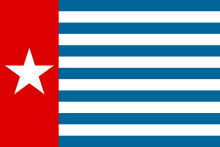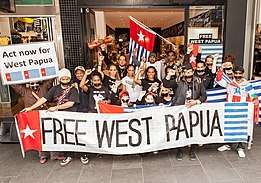Morning Star flag
The Morning Star flag (Indonesian: Bendera Bintang Kejora, Dutch: Morgenstervlag) was a flag used in a supplemental fashion on Netherlands New Guinea to the flag of the Netherlands. It was first raised on 1 December 1961 prior to the territory coming under administration of the United Nations Temporary Executive Authority (UNTEA) on 1 October 1962.[1]
 | |
| Name | The Morning Star flag |
|---|---|
| Adopted | 1 December 1961 |
| Design | Thirteen blue and white alternating horizontal stripes with a red bar on the hoist side with a white five pointed star centered on it |
| Designed by | Nicolaas Jouwe[1] |
The flag is used by the Free Papua Organization and other independence supporters.[2] Under Papua's Special Autonomy Law, ratified in 2002, the flag may be raised in Western New Guinea (West Papua) region so long as the flag of Indonesia is also raised and it is higher than the Morning Star flag.[3] The flag consists of a red vertical band along the hoist side, with a white five-pointed star in the center, and thirteen horizontal stripes, alternating blue and white, with seven blue stripes and six white ones.[4]
History
After territorial elections in February 1961 the New Guinea Council a representative body consisting of 28 members were sworn into office by Governor Dr. P.J.Platteel on 1 April 1961 and the Council's inaugurations on 5 April 1961 were attended by Australia, France, the Netherlands, New Zealand, the United Kingdom and other Pacific Forum nations with exception of the United States.[5][1] The Council appointed a National Committee to draft a manifesto expressing the desire for independence, and to design a flag and anthem commensurate with this desire.[1][6][7] The design of the flag is credited to Nicolaas Jouwe.[1] The full New Guinea Council endorsed these actions on 30 October 1961 and the first Morning Star flag was presented to Governor Platteel on 31 October 1961.[1][8] The Dutch authorities did not accept the denomination of the flag, recognising it as a territorial flag (landsvlag) not a national flag.[1]
An inauguration ceremony was held on 1 December 1961 with the flag officially raised for the first time outside the Council's building in the presence of the Governor together with the Dutch flag.[1][9][10][6]
On 1 July 1971 at Markas Victoria (Victoria Headquarters) in West Papua, Brigadier General Seth Jafeth Rumkorem, leader of the militant independence movement Free Papua Movement (Indonesian: Organisasi Papua Merdeka, (OPM)), proclaimed unilaterally Papua Barat or West Papua as an independent democratic republic.[11] The Morning Star flag was declared as a national flag.[1]
Modern use
The Morning Star is flown by Papua independence movements and supporters across the world. Special ceremonies take place on 1 December of each year, to commemorate the first flag raising in 1961. The flying of the Morning Star is seen by Indonesian authorities as advocating independence challenging Indonesian sovereignty.

Two Papuan men, Filep Karma and Yusak Pakage, were sentenced to 15 and 10 year sentences for raising the flag in Jayapura in 2004.[12][13] Pakage was released in 2010, having served five years of his term.[14] Karma was released in November 2015 and has alleged abuse at the hands of prison authorities during his incarceration.[13] Amnesty International considered both men prisoners of conscience and named Karma a 2011 "priority case."[15]
References
- Tanggahma, Leonie (1 December 2012). "A History of the Morning Star Flag of West Papua". West Papua Media. Retrieved 21 October 2017.
- "Free West Papua Campaign Official website".
- Goldsmith, Ben; Brauer, Jurgen (2010). Economics of War and Peace: Economic, Legal, and Political Perspectives. Emerald Group Publishing. p. 101.
- "Papua". Hubert de Vries - National Arms and Emblems - Past and Present. 2012. Retrieved 21 October 2017.
- Dutch New Guinea. Reuters TV (Television production). Reuters. 14 April 1961. 2639/61. Retrieved 22 October 2017.
- Chauvel, Richard (2005). Constructing Papuan Nationalism: History, Ethnicity, and Adaptation (PDF). Policy Studies 14. Washington: East-West Center Washington. ISSN 1547-1330. Archived from the original (PDF) on 16 July 2007.
- Dutch New Guinea: Papuans choose new flag and national anthem. Reuters TV (Television production). Reuters. 25 October 1961. 7777/61. Retrieved 22 October 2017.
- Dutch New Guinea renamed West Papua: new national flag approved by Netherlands government. Reuters TV (Television production). Reuters. 5 November 1961. 8126/61. Retrieved 22 October 2017.
- West Papua: West Papuan flag hoisted in Hollandia. Reuters TV (Television production). Reuters. 7 December 1961. 8950/61. Retrieved 22 October 2017.
- "Colony's Name Changed" (PDF). New York Times. 1 December 1961. p. 4. Retrieved 21 October 2017.
- "West Papua". Unrepresented Nations and People Organization (UNPO). 15 October 2014. Archived from the original on 2 June 2019. Retrieved 20 October 2017.
- Richard Chauvel (6 April 2011). "Filep Karma and the fight for Papua's future". inside.org.au/. Retrieved 18 April 2011.
- Rebecca Henschke (3 August 2010). "Papua activist Filep Karma 'abused in prison'". BBC News. Retrieved 18 April 2011.
- "Indonesian Prisoner Yusak Pakage Released!". Amnesty International. 7 July 2010. Retrieved 19 April 2011.
- "Filep Karma, Jailed for Raising a Flag". Amnesty International. 2011. Archived from the original on 29 April 2011. Retrieved 18 April 2011.
Further reading
- Peter D. King, West Papua & Indonesia Since Suharto: Independence, Autonomy, or Chaos (ISBN 0-86840-676-7), p. 31–32
- Richard Chauvel, Centre of Southeast Asian Studies Working Papers – Working Paper 121: Essays on West Papua, Vol. 2